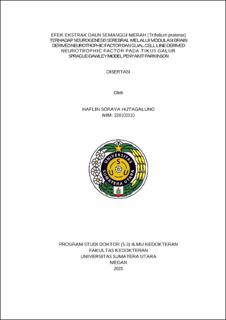Efek Ekstrak Daun Semanggi Merah (Trifolium pratense) Terhadap Neurogenesis Serebral Melalui Modulasi Brain Derived Neurotrophic Factor dan Glial Cell Line-Derived Neurotrophic Factor Pada Tikus Galur Sprague-Dawley Model Penyakit Parkinson
Effects of Red Clover Leaf Extract (Trifolium pratense) Against Cerebral Neurogenesis Through Modulation of Brain Derived Neurotrophic Factor and Glial Cell Line-Derived Neurotrophic Factor in the Sprague-Dawley Rat Model Parkinson's disease

Date
2025Author
Hutagalung, Haflin Soraya
Advisor(s)
Rambe, Aldy Safruddin
Widyawati, Tri
Amin, Mustafa Mahmud
Metadata
Show full item recordAbstract
Introduction: Parkinson's disease (PD) is characterized by the progressive degeneration of dopaminergic neurons in the substantia nigra pars compacta caused by multifactorial factors. However, until now, the administration of standard drugs has not been found to slow down the progression of PD. Red clover (Trifolium pratense) leaves extract, which belongs to the isoflavone group, has the potential to enhance neurotrophic factors that play a role in the process of neurogenesis. The increase in neurotrophic factors BDNF and GDNF reflects that isoflavones also have the potential for the formation of new neurons in brain tissue. This study aims to examine the role of red clover (Trifolium pratense) leaves extract on cerebral neurogenesis through the modulation of neurotrophic factors (BDNF and GDNF) in Sprague-Dawley strain rats as a PD model.
Methods: A total of 35 Sprague-Dawley strain rats with the PD model were used as samples in this in-vivo experimental study, and then randomized into 5 groups. All rats, except for the normal group (group N), were injected with rotenone intraperitoneally for 1 week to induce the PD model, followed by behavioral tests (Rotarod test and Morris water maze test). On the 8th day after rotenone injection, the groups of rats without Trifolium pratense leaves extract (NC), Trifolium pratense leaves extract 5 mg for 28 days (ET5), Trifolium pratense leaves extract 10 mg for 28 days (ET10), and Trifolium pratense leaves extract 20 mg for 28 days (ET20). On day 36, the levels of BDNF and GNDF in the brain tissue were examined by ELISA. Tyrosine hydroxylase (TH) and Ki-67 protein in brain tissue were assessed using immunohistochemical examination. Lewy Body (LB) was assessed through histopathological examination as well as the evaluation of the Rotarod test and Morris water maze test.
Results: ET5 group (5 mg of Trifolium pratense leaves extract) effectively increases BDNF levels in the PD rat model compared to NC (140.59 vs 92.36 pg/mL, p<0.05). The 10 mg Trifolium pratense leaves extract (ET10) was also found to effectively increase GDNF levels compared to the control (104.63 vs 51.21 pg/mL, p<0.05). The 20 mg Trifolium pratense leaves extract (ET20) was proven to increase TH expression (p<0.01), reduce LB formation (p<0.05), and enhance Ki-67 protein expression (p<0.001). The administration of ET 10 in the rotarod test was found to sustain longer at a speed of 40 rpm, and in the Morris water maze test, it reached the platform faster on day 28. The ET 20 group in the rotarod test also sustained for a long time at speeds of 20 rpm and 60 rpm.
Conclusion: The extract of Trifolium pratense leaves has been proven effective in increasing the formation of TH, Ki-67 protein, reducing the formation of LB, and improving motor coordination and spatial memory through the modulation of neurotrophic factors BDNF and GDNF.
Collections
- Doctoral Dissertations [185]
